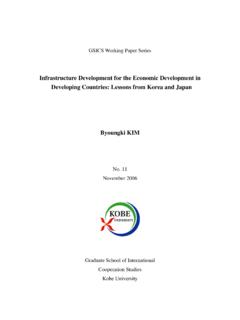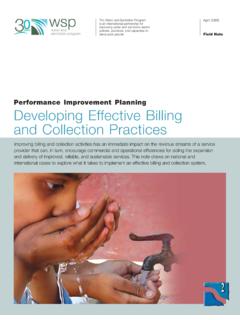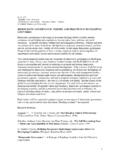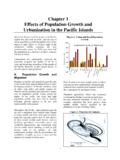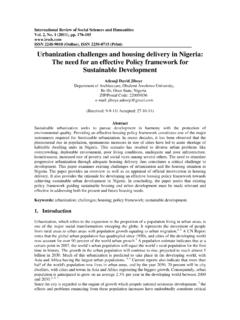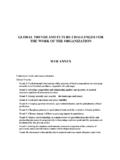Transcription of Review of Best Practice in Interventions to Promote ...
1 Review of Best Practice in Interventions to Promote Physical Activity in developing Countries Background Document prepared for the WHO Workshop on Physical Activity and Public Health 24 27 October 2005 Beijing, People s Republic of China World Health Organization 2008 All rights reserved. Publications of the World Health Organization can be obtained from WHO Press, World Health Organization, 20 Avenue Appia, 1211 Geneva 27, Switzerland (tel.: +41 22 791 3264; fax: +41 22 791 4857; e-mail: Requests for permission to reproduce or translate WHO publications whether for sale or for noncommercial distribution should be addressed to WHO Press, at the above address (fax: +41 22 791 4806.))
2 E-mail: The designations employed and the presentation of the material in this publication do not imply the expression of any opinion whatsoever on the part of the World Health Organization concerning the legal status of any country, territory, city or area or of its authorities, or concerning the delimitation of its frontiers or boundaries. Dotted lines on maps represent approximate border lines for which there may not yet be full agreement. The mention of specific companies or of certain manufacturers products does not imply that they are endorsed or recommended by the World Health Organization in preference to others of a similar nature that are not mentioned.
3 Errors and omissions excepted, the names of proprietary products are distinguished by initial capital letters. All reasonable precautions have been taken by the World Health Organization to verify the information contained in this publication. However, the published material is being distributed without warranty of any kind, either expressed or implied. The responsibility for the interpretation and use of the material lies with the reader. In no event shall the World Health Organization be liable for damages arising from its use.
4 This publication does not necessarily represent the decisions or the stated policy of the World Health Organization. This background document was prepared by: A. Bauman, S. Schoeppe and M Lewicka (Center for Physical Activity and Health, School of Public Health, University of Sydney, Australia), in collaboration with T. Armstrong, V. Candeias and J. Richards (WHO Headquarters, Geneva, Switzerland), for the WHO Workshop on Physical Activity and Public Health, Beijing, China, held on 24 27 October 2005. 4 Contents _____ EXECUTIVE 1.
5 BACKGROUND .. 9 2. METHODOLOGICAL 14 3. RESULTS .. 19 4. CONCLUSIONS .. 83 5. REFERENCES .. 89 6. ANNEX 1 CLASSIFICATION OF HIGH-INCOME ECONOMIES ECONOMIES .. 922 7. ANNEX 2 ESTABLISHED MARKET ECONOMIES .. 93 8. ANNEX 3 BEST Practice PHYSICAL ACTIVITY Interventions IN developing COUNTRIES IN SUMMARY .. 94 9. ANNEX 4 KEY STAKEHOLDERS FROM COUNTRY CONSULTATIONS .. 110 Executive Summary 5 Executive summary Background.
6 Physical inactivity, along with other lifestyle-related health risk factors ( unhealthy diet, tobacco use, alcohol consumption), is becoming increasingly prevalent in developing countries which face rapid economic and social development, urbanization and industrialization. Associated noncommunicable diseases (NCDs) such as cardiovascular diseases, diabetes and cancer have risen in prevalence rapidly in transitional countries, and their prevention and control is now a major challenge for leading governmental and nongovernmental organizations (NGOs).
7 The importance of physical activity as a means of NCD prevention and control is recognized in developing countries, as well as the need for suitable programmes, policies and guidelines. However, the evidence base on implementing physical activity Interventions in the developing country context is sparse. The same applies to the development of national physical activity policies and guidelines. Purpose of the Review : This Review aims to address the evidence gap by describing physical activity Interventions in developing countries (current Practice ), and compiling case studies of those Interventions thought to be successful (current best Practice ), for example, in terms of raising awareness of the benefits of physical activity and increasing participation in physical activity.
8 This information will then support WHO initiatives towards the development of guidelines for implementing physical activity Interventions in developing countries. The main focus of this Review was Interventions initiated by ministries of health, sport and/or education and conducted on a large scale (national, state, province level). However, intervention implementation usually includes components at the local level (community, school, workplace). In addition, the Review contributes to documentation of national physical activity guidelines as well as policies on physical activity (or NCD disease prevention/obesity prevention/health promotion including physical activity) in developing countries.
9 This provides valuable information on the context in which physical activity Interventions take place. Methodological approach: For the Review , developing countries were defined by exclusion, with countries excluded if they were OECD high-income countries. Physical activity Interventions were defined as systematic approaches to increase any of the various domains of physical activity (occupation, transport, domestic chores, leisure-time), using a range of intervention strategies ( raising awareness, education, skill development, increasing physical activity Practice )
10 , either Executive Summary 6focusing on physical activity promotion in particular, or healthy lifestyle promotion with physical activity as one component in addition to other lifestyle factors ( diet, tobacco use, alcohol consumption).











